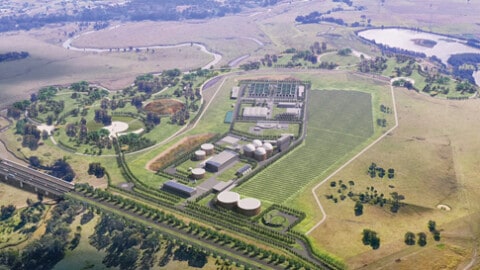A brownfield high-voltage substation construction project in Alice Springs by Power and Water Corporation has seen a new lease on life for previously unused switchgear.
The 11kV air insulated switchgear (AIS), which was originally sourced for another project a number of years ago, has been retrofitted to make it suitable for use at the corporation’s Sadadeen Substation.
This $12 million project will see the construction of a new building and installation of the switchgear to replace existing systems approaching the end of their life.
“The electricity needs of Alice Springs have been changing over the years, and we’re very conscious of the need to ensure the reliability and security of the power network is maintained,” Sam Bakara, Project Manager at Power and Water, said.
“This project has allowed us to further invest in the future of Alice Springs while also developing capacity and knowledge to undertake further upgrades to other aging substation assets in the future.”
Overcoming brownfield site challenges
The Sadadeen site posed additional challenges for Power and Water as it is an operational brownfield site.
The design and construction phase required multiple engineering skillsets, including high and low voltage electrical, communications, civil, building and mechanical expertise.
In terms of works, the project required the installation of new underground electrical conduits and connection to existing aboveground distribution assets at a number of fixed locations.
It also saw the construction of a new switchroom building and indoor equipment on Power and Water-owned land, adjacent to the existing substation, and connections to the existing outdoor transformers and equipment.
New underground conduits will also be installed within the Sadadeen Substation site.
“Working with our contractors, we’ve had to take special care to ensure these ongoing works involve minimal disruptions to the power supply of Alice Springs, especially as it can reach temperatures of up to 40° Celsius in summer,” Mr Bakara said.
“Additionally, we have had to take careful measures in the installation of new infrastructure due to existing underground services potentially being in the way.
“These include existing services like water, sewerage, gas, diesel, telecommunications and power services infrastructure.”
Retrofit solution a practical choice
 According to Mr Bakara, the choice of whether to repurpose the switchgear that had been in storage was carefully considered and assessed as a cost-efficient solution.
According to Mr Bakara, the choice of whether to repurpose the switchgear that had been in storage was carefully considered and assessed as a cost-efficient solution.
Additional work was required to retrofit Power and Water’s existing equipment to ensure it was fit-for-purpose to operate in the Sadadeen network.
Consideration was also given to the type of switchgear used.
“AIS was chosen as it complies with our standard arrangement for switchgear. The other option was gas insulated switchgear (GIS),” Mr Bakara said.
“There are benefits to both using AIS or GIS switchgear; it really depends on the application.
“One of the main benefits for AIS is its historically competitive cost compared to GIS. However, GIS works well if there are constraints in the land available as GIS is much more compact than AIS.”
Modern protection and control equipment will also be installed to operate the system, prevent equipment damage and ensure the safety of the network.
“This equipment is installed remote to the switchgear, but has a direct interface to the switchgear through low-voltage wiring and other communication channels,” Mr Bakara said.
The retrofitted panels were transported almost 1,500km to Alice Springs from Darwin after undergoing final test and protection checks in early November 2019.
“The switchgear will then require connection of high-voltage feeder cables from below the switchgear,” Mr Bakara said.
“We’ve designed the switchroom so that the cables enter the building via cable ducts and are installed at the bottom of the cable ducts.
“Finally, the switchgear will be tested and commissioned after installation, and energised into service.”
The construction works are scheduled to be completed by April 2020, with testing and commissioning into service commencing May 2020. The new equipment is expected to be fully operational by August 2020.
















